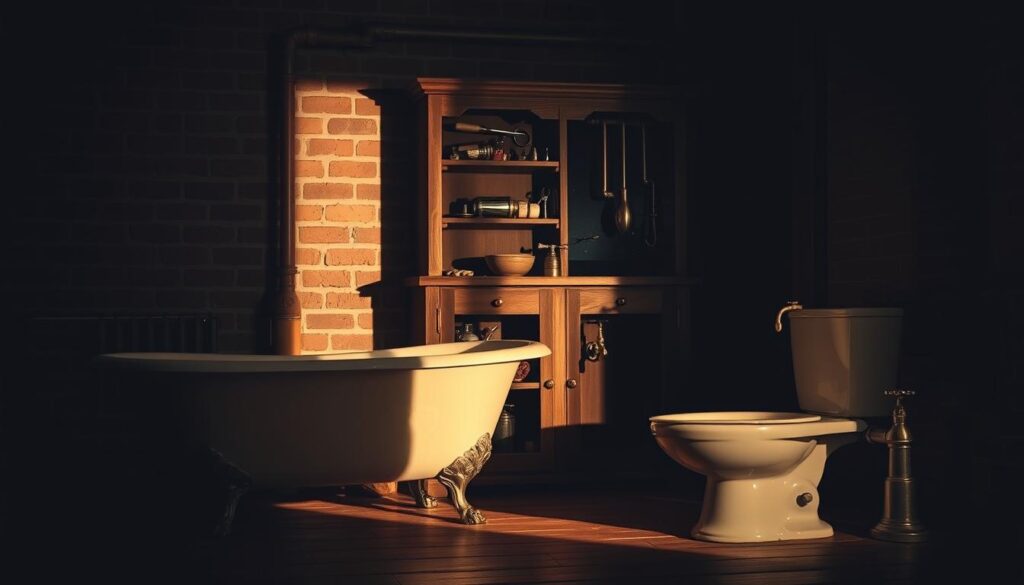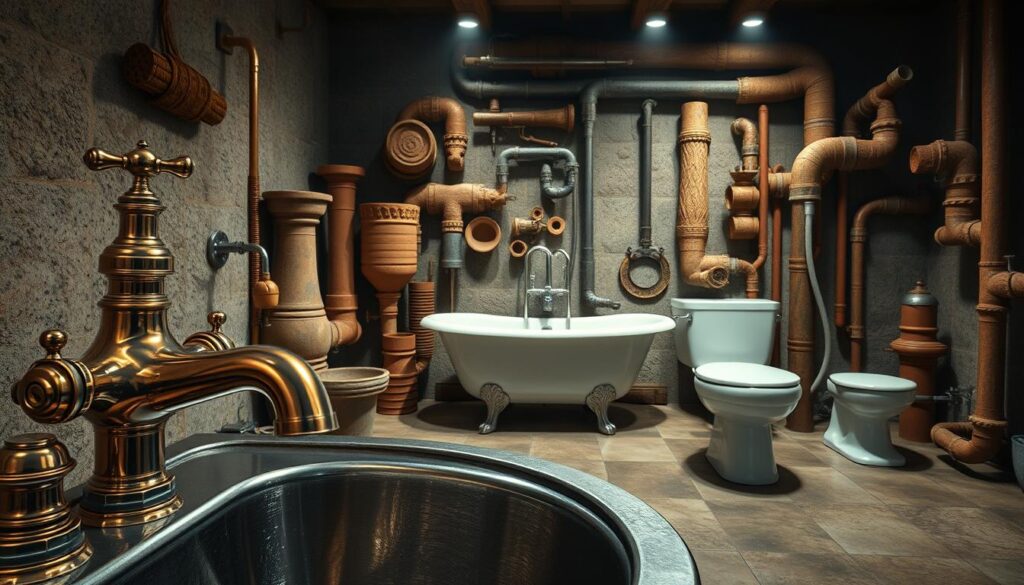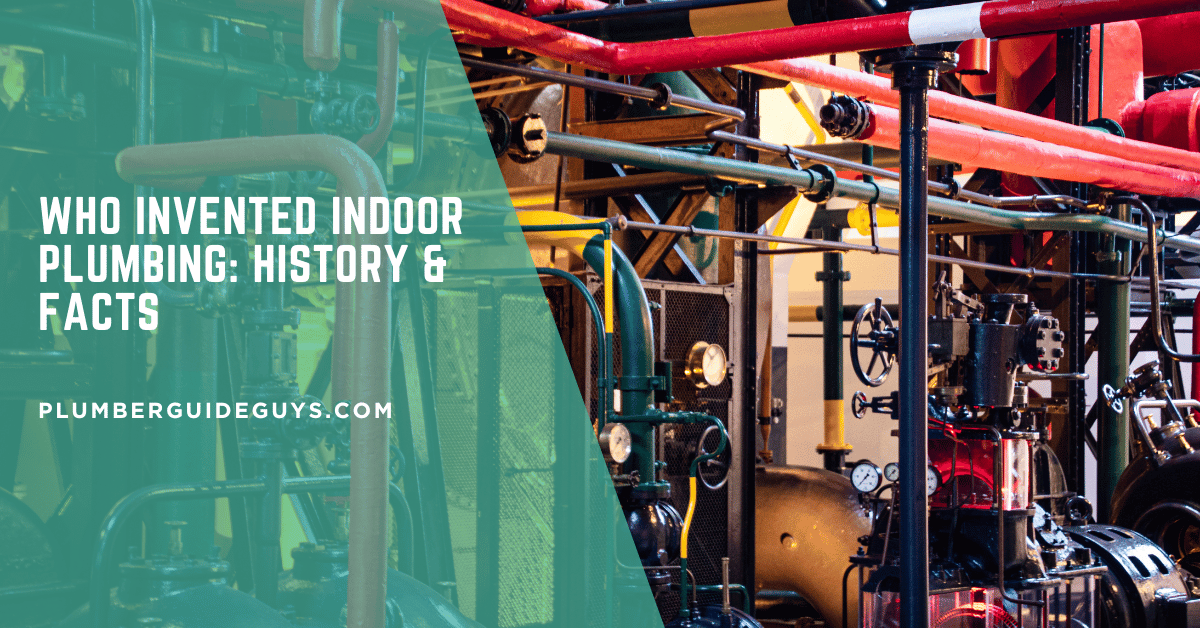Affiliate Disclosure
Plumber Guide Guys is a participant in the Amazon Services LLC Associates Program, an affiliate advertising program designed to provide a means for sites to earn advertising fees by advertising and linking to Amazon.
Who Invented Indoor Plumbing? Imagine a cold winter morning in medieval Europe. Getting water meant going to a far-off well. You had to carry heavy buckets in the freezing cold. The story of indoor plumbing is a big change in how we live, work, and stay clean.

Looking into who invented indoor plumbing shows it’s a long story. It’s not just one person’s idea. It’s a journey of thousands of years. Ancient civilizations created amazing ways to manage water before we had today’s technology.
From the Indus Valley’s advanced water systems to the Roman aqueducts, people have always wanted better water management. Learning about these early achievements shows how important indoor plumbing is for our progress and health.
Key Takeaways
- Indoor plumbing is a result of centuries of technological development
- Ancient civilizations made significant contributions to water management
- The invention of indoor plumbing cannot be credited to a single person
- Water systems dramatically improved human living conditions
- Technological advancements continue to enhance plumbing infrastructure
Table of Contents
The Origins of Indoor Plumbing in Ancient Civilizations
Ancient civilizations created amazing plumbing systems. These systems were the start of modern water management. They showed a deep understanding of moving water and removing waste, long before today’s tech.
For thousands of years, humans have been working on indoor plumbing. They wanted clean water and good waste management. This drive led to big tech advances across cultures.
Early Mesopotamian Innovations
Mesopotamian societies were leaders in plumbing tech. They used advanced water management. This included:
- Clay pipe networks for water transport
- Drainage systems in cities
- Advanced irrigation channels
“Water is the driving force of all nature.” – Leonardo da Vinci
Ancient Roman Engineering Achievements
Roman engineers made huge strides in plumbing. They built aqueducts that carried water far. This showed their amazing engineering skills.
- Big public bath complexes
- Lead pipe water systems
- Advanced sewage systems
The Minoan Civilization’s Advanced Systems
The Minoans of Crete had advanced plumbing. Their buildings showed great plumbing skills. They included:
- Complex multi-story drainage
- Early flushing toilets
- Complex water networks
These ancient achievements show humans have always valued good water management and sanitation.
Ancient Indoor Plumbing Systems Around the World
Ancient civilizations showed great engineering skills in creating early bathroom technology. They worked hard to find clean water and good sanitation. This led to amazing advancements in indoor plumbing.
The Indus Valley Civilization was a leader in urban sanitation. Their cities had drainage systems that would amaze today’s engineers. They built underground sewage networks that connected homes, showing a complex water management system.
- Harappa and Mohenjo-daro had advanced water distribution systems
- Brick-lined drainage channels kept waste away
- Each home had water access through a central network
Ancient Egyptian engineers also made big contributions. Archaeologists found copper water pipes in pyramids. This showed their skill in moving water. It made living conditions better and improved hygiene.
| Civilization | Plumbing Innovation | Key Achievement |
|---|---|---|
| Indus Valley | Underground Sewage Systems | Citywide Water Management |
| Ancient Egypt | Copper Water Pipes | Advanced Water Transportation |
| Ancient China | Well Drilling | Reliable Water Sources |
Chinese civilizations had their own ways of solving plumbing problems. They developed great well-drilling techniques and water distribution methods. These helped communities get clean water and manage waste well.
The evolution of ancient indoor plumbing shows human creativity in solving basic survival needs.
The Evolution of Early Water Supply Systems
Exploring the history of plumbing shows how humans have always sought to manage water. Early societies knew water was key and created systems that are the basis of today’s plumbing.
Water was vital for survival in ancient times. Communities worldwide found ways to get and share water.
Development of Wells and Water Extraction
At first, people used wells to get water. They dug deep to find underground water:
- Hand-dug vertical shafts reaching underground water tables
- Lined wells using stone and clay materials
- Specialized digging techniques to prevent collapse
Advanced Water Distribution Methods
Later, plumbing got a lot better with new ways to move water:
| Civilization | Water Distribution Technology | Key Innovation |
|---|---|---|
| Roman Empire | Aqueduct Networks | Gravity-based water transportation |
| Persian Empire | Qanat Systems | Underground water channel networks |
| Greek Cities | Lead Pipe Infrastructure | Pressurized water distribution |
Early Drainage Solutions
Drainage was also key in managing water. Ancient engineers came up with ways to keep cities clean:
- Sloped street designs for water runoff
- Underground sewage channels
- Waste management through strategic water flow
These early solutions show how clever humans were in solving water problems. They paved the way for today’s plumbing.
Who Invented Indoor Plumbing: Key Historical Figures
The story of indoor plumbing is complex, involving many brilliant minds. It’s not just about who invented the first indoor toilet. Instead, it’s a journey of many innovators.
Sir John Harington was a key figure in indoor plumbing. In 1596, he made a flush toilet for Queen Elizabeth I. His design was ahead of its time, with a water flush that shaped today’s toilets.
- Sir John Harington: Created the first documented flush toilet in 1596
- Alexander Cummings: Patented key toilet design improvements in 1775
- Thomas Crapper: Improved toilet technology in the late 19th century
“Necessity is the mother of invention, and indoor plumbing was born from humanity’s desire for improved sanitation and comfort.”
Alexander Cummings made a big leap in 1775 with the S-trap. It stopped sewer gases from entering homes, solving a major health issue. His patent was a key moment in indoor plumbing history.
These inventors worked together, building on each other’s ideas. Their work made indoor plumbing a common feature in homes, greatly improving health and life quality.
Revolutionary Developments in Medieval Times
The medieval period was a key time for indoor plumbing. It saw big steps forward in the Islamic world and Europe. These advancements changed how people handled water and waste.
During this time, new technologies were born. They helped create modern ways to manage water. People started to see how important clean water and waste removal were.
Islamic World’s Contributions
Islamic cities led in water infrastructure. They had better systems than Europe. Their engineers created:
- Intricate underground water channels
- Advanced public bathhouse systems
- Sophisticated drainage networks
Cities like Baghdad and Damascus showed off their skills. They had complex water systems that amazed people.
European Plumbing Innovations
In Europe, plumbing grew slowly but was important. Monasteries and castles started using better water management.
| Location | Plumbing Innovation | Significance |
|---|---|---|
| Monasteries | Centralized Water Systems | Improved community hygiene |
| Castles | Early Waste Removal Techniques | Enhanced living conditions |
| Urban Centers | Rudimentary Sewage Networks | Reduced disease transmission |
These medieval steps were important. They connected old ways with new technologies.
The Birth of Modern Plumbing Systems

The 19th century was a game-changer for indoor water systems. Cities in the United States started building new plumbing systems. These changes would forever alter how people lived in cities.
Municipal water supply networks were a big step forward. Cast iron pipes replaced old wooden ones, making water transport better. This allowed cities to grow fast, supporting more people with good water systems.
- Introduction of centralized water management
- Development of advanced pipe technologies
- Implementation of sophisticated drainage systems
New technologies like the ball-cock mechanism changed how water tanks worked. Hydraulic engineering became more advanced, helping control and distribute water better.
The transformation of urban water systems represented more than technological progress—it was a public health revolution.
Engineers and city planners teamed up to create better water management. They knew good plumbing systems were key to health and well-being in communities.
By the late 19th century, big cities had the water systems we use today. The evolution of indoor water systems changed how Americans saw sanitation, hygiene, and city services.
Pioneering Inventors and Their Patents
The history of indoor plumbing is filled with groundbreaking innovations. These came from remarkable inventors who changed how we view sanitation and waste management. Their work led to the modern bathrooms we use today.
Many inventors played a big role in the development of indoor toilets. Their patents and innovations greatly improved public health and comfort.
Sir John Harington: The First Indoor Toilet Inventor
Sir John Harington, an English nobleman, invented the first indoor toilet in 1596. His design had a raised cistern that used water to flush waste. This was a big step forward in sanitation technology.
- Designed for Queen Elizabeth I’s palace
- Used a valve mechanism to remove waste
- Advanced concept of water-based waste removal
Thomas Crapper: Plumbing Innovation Pioneer
Thomas Crapper didn’t invent the toilet, but he made it better. He came up with many plumbing innovations. These improved toilet function and raised awareness about sanitation.
| Innovation | Impact |
|---|---|
| Improved Flush Mechanism | More efficient water usage |
| Manhole Covers | Enhanced sewer system safety |
| Toilet Showroom | Increased public understanding of sanitation |
Alexander Cummings: The S-Trap Revolution
Alexander Cummings introduced the S-trap design in 1775. It stopped sewer gases from getting into buildings. This innovation became a key part of modern plumbing.
- Patented S-shaped pipe design
- Created water seal preventing odors
- Significantly improved indoor hygiene
These inventors made indoor plumbing essential, not just a luxury. They helped create the sanitation standards we enjoy today.
Indoor Plumbing’s Impact on Public Health

The history of indoor plumbing is a big step forward for human health. Before indoor plumbing, waterborne diseases were a huge problem. These diseases killed many people. Indoor plumbing changed this, making sanitation and disease prevention much better.
“Clean water is the foundation of human health and civilization.” – Water Research Foundation
Indoor plumbing has brought many health benefits:
- Dramatic reduction in cholera and typhoid outbreaks
- Improved personal hygiene practices
- Enhanced waste management systems
- Decreased infant mortality rates
Cities with advanced plumbing saw big health improvements. Clean water and better waste management were key. They changed how we fight public health problems.
| Health Metric | Pre-Modern Plumbing | Post-Modern Plumbing |
|---|---|---|
| Waterborne Disease Rates | High (30-40%) | Low (2-5%) |
| Infant Mortality | 25-30 per 1,000 births | 5-7 per 1,000 births |
Today, indoor water systems keep getting better. They use new technologies and green practices. Knowing how plumbing helps health shows how far we’ve come in keeping communities safe.
The Industrial Revolution and Plumbing Advancements
The Industrial Revolution changed plumbing systems a lot. It brought new tech that made indoor water systems better. By the late 18th and early 19th centuries, pipes and fixtures were made easier to get. This helped more people in cities have access to water.
Some big tech wins during this time were:
- Mass production of cast iron pipes
- Advanced water pumping technologies
- More efficient water heating systems
- Standardized plumbing components
As cities grew, they needed better water supply infrastructure. Cities worked hard to build big sanitation networks. These networks could handle the growing number of city people.
| Industrial Era Plumbing Innovation | Impact |
|---|---|
| Cast Iron Pipe Manufacturing | Increased durability and water distribution efficiency |
| Steam-Powered Water Pumps | Improved water transportation across greater distances |
| Standardized Plumbing Fixtures | Reduced installation costs and improved maintenance |
These big changes made plumbing a must-have, not just a luxury. They helped create the water systems we use today.
Conclusion
The history of indoor plumbing is truly fascinating. It shows how humans have always been innovating. From ancient times to now, we’ve made huge steps forward.
Ancient people like the Minoans, Romans, and Mesopotamians started it all. They created the first water systems. These early steps paved the way for today’s plumbing.
Over time, plumbing has changed a lot. We’ve moved from simple clay pipes to complex networks. People like Thomas Crapper and Alexander Cummings played big roles in these changes.
Their work made a huge difference in our health and cleanliness. It shows how important plumbing is to our daily lives.
Today, plumbing keeps getting better. Your bathroom is a result of amazing engineering from many cultures and minds. This story shows how working together can solve big problems and make life better.
As technology keeps growing, plumbing will keep improving too. What started as basic needs has become key to our health and comfort. Knowing this history helps us value the systems we use every day.

